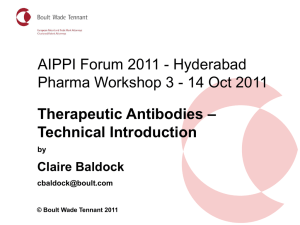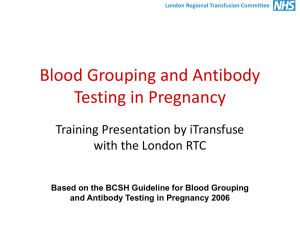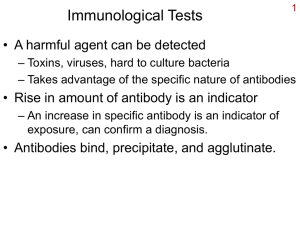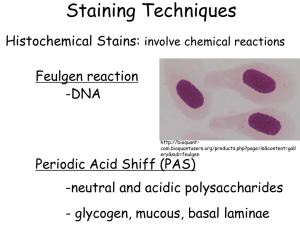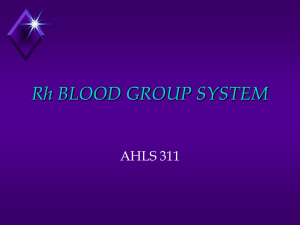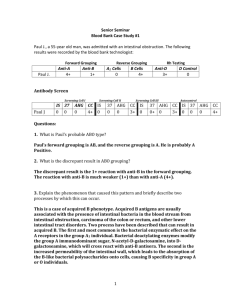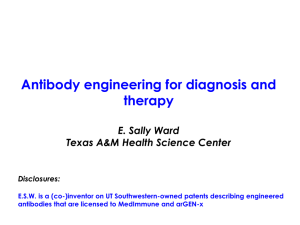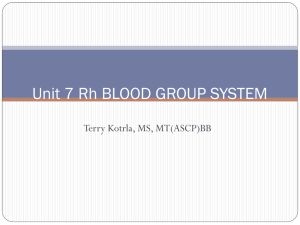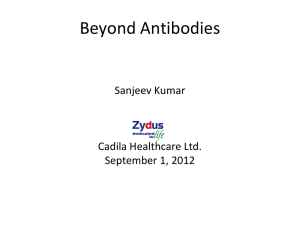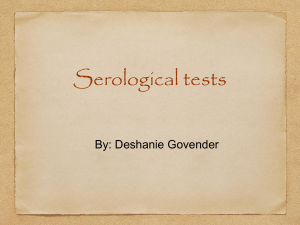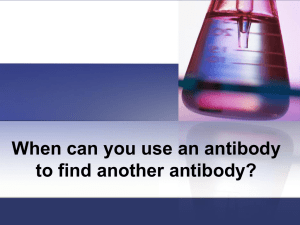Rh System Antibodies
advertisement
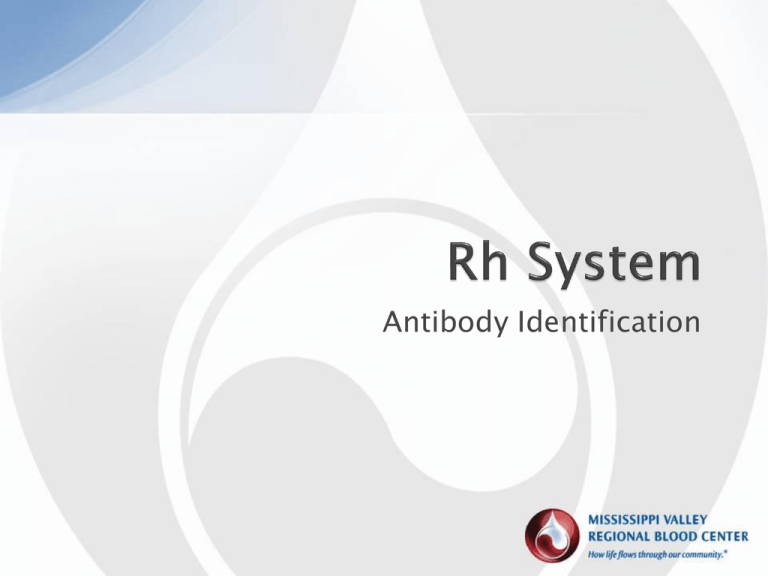
Antibody Identification Most important blood group system in blood transfusion medicine. (after ABO) 1939 – Levine and Stetson 1st discovered antibody 1940 – Landsteiner and Weiner discovered antibody developed by using Rhesus monkey cells. 1960’s- Discovered the antibody produced by the pregnant woman and the Rhesus monkeys were actually two different, distinct antibodies. Fisher Race – D, C, E, d, c, e ◦ 3 sets of genes produce the antigens Examples: ◦ DCe/dce ◦ DcE/DCE Weiner – R1, R2, r ◦ Inheritance of all Rh antigens lies under control of one gene Examples: ◦ R1R2 ◦ R1r’ ◦ R0r International Society of Blood Transfusion ◦ Uniform nomenclature both eye and machine readable D = RH1 C = RH2 E = RH3 c = RH4 e = RH5 RHD and RHCE genes located on Chromosome 1 Over 100 RHD and 50 RHCE alleles have been identified RHAG (RHAG) Rh associated glycoprotein LW gene located on Chromosome 4 located on Chromosome 6 PS1 RHAG PS2 CDE RH genes LW LW genes Extends 12 spans of the RBC membrane Integral part of the red cell membrane Linked to membrane skeleton D antigen is comprised of multiple epitopes Persons with one or more epitopes missing from the red cells can produce an immune response when exposed to the common form of the D antigen Cells generally type normally as D+ since typing reagents are designed to detect multiple epitopes Classification of Partial D Epitopes Category II IIIa IIIb IIIc Iva Ivb Va Vb Vc VI Early reagents relied on antibodies produced by women sensitized by pregnancy or in hyperimmunized volunteers. Monoclonal antibody technology was introduced in the 1980’s. ◦ But monoclonal antibodies are specific for a single D epitope Does not detect all D-positive red cells. Current reagents are blends containing monoclonal IgM antibody plus monoclonal or polyclonal IgG antibody ◦ IgM allows for RT reactivity ◦ IgG allows for AHG testing and detection of Weak D Must read package insert to see which variants it detects ◦ Gammaclone – reacts at AHG with DVI, DBT, DHar, Crawford ◦ Immucor Series 4 and 5 reagents do not react with Crawford ◦ OrthoBioclone does not react with Dhar or Crawford Enhanced by enzymes Not affected by DTT, Chloroquine, EGA treatment Anti-D vs Anti-LW Anti-LW reacts with all adult cells ◦ Reacts stronger with Rh+ cells ◦ Reacts weaker with Rh- cells Anti-LW reacts strongly with Rh+ or Rh- Cord cells Anti-LW destroyed by DTT Cell D 1 + + 0 0 + 0 + + 0 + 0 + + + + 0 0 + + + 0 + 0 + 0 + + 0 + + 0 0 + 0 + + + + + + 0 0 + + + + 0 0 + 0 0 + + 0 2+ 0 + 2+ 0 0 + 2+ 0 + 2+ 0 0 + 0 + + 0 + + 0 + 0 + + 0 0 + + + 0 + + 0 + + + 0 0 0 0 + + + + 0 + + + + 0 0 0 0 + + 0 + 0 + 0 0 + + 0 + w/0 + 0 w/0 0 + + w/0 0 + w/0 0 2 3 4 5 6 7 8 9 PC Rh= cord C E c e K k Fy a Fy b Jk a Jk b M N S s AHG Gel DTT 0 0 0 0 + + 0 0 + 0 + + + + 0 0 + + 0 2+ 0 0 2+ 0 0 Anti-f f antigen is expressed on RBCs having c and e on the same haplotype (cis). ◦ R1r DCe/dce f antigen is not expressed when c and e occur on separate haplotypes (trans). ◦ R1R2 DCe/DcE 65% Caucasian population, 92% African Americans, 12% Asians Cell D C E c e K k Fy a Fy b Jka Jk b M N S s AHG Gel 1 + + 0 0 + 0 + + 0 + 0 + + + 0 0 2 + + 0 0 + + + 0 + 0 + 0 + 0 + 0 3 + 0 + + 0 0 + 0 + + + + + 0 + 0 4 + 0 0 + + + + 0 0 + 0 0 + 0 + 2+ 5 0 + 0 + + 0 + + 0 + 0 + + 0 + 2+ 6 0 0 + + + 0 + + 0 + + + 0 + 0 2+ 7 0 0 0 + + + + 0 + + + + 0 + + 2+ 8 0 0 0 + + 0 + 0 + 0 0 + + 0 + 2+ 9 0 0 0 + + 0 + + + + 0 0 + + 0 2+ PC 0 Anti-G Inseparable anti-CD G antigen is present on ANY cell with the C or D antigen, or both But there have been cases of D-C-G+ and D+GMust perform adsorb/elution studies to confirm presence Patient can have both anti-G plus anti-D or anti-C. Cell D C E c e K k Fy a Fy b Jka Jk b M N S s AHG Gel 1 + + 0 0 + 0 + + 0 + 0 + + + 0 3+ 2 + + 0 0 + + + 0 + 0 + 0 + 0 + 3+ 3 + 0 + + 0 0 + 0 + + + + + 0 + 3+ 4 + 0 0 + + + + 0 0 + 0 0 + 0 + 3+ 5 0 + 0 + + 0 + + 0 + 0 + + 0 + 3+ 6 0 0 + + + 0 + + 0 + + + 0 + 0 0 7 0 0 0 + + + + 0 + + + + 0 + + 0 8 0 0 0 + + 0 + 0 + 0 0 + + 0 + 0 9 + + 0 + + 0 + + + + 0 0 + + 0 3+ PC 0 Ro (Dce) Will adsorb out true anti-D while leaving separate anti-C Antibody will be coating cells after adsorption Perform elution to harvest coating antibody Perform antibody identification on eluate If shows anti-D plus anti-C pattern = ANTI-G If shows only anti-D, then have separate anti-D and anti-C antibodies hrs hrb e mosaic V/VS e The e antigen is considered to be a mosaic ◦ Correct terminology is Partial The antigens in the mosaic are e, hrs ,hrb, V, and VS hrs antibody is similar to anti-ce hrb antibody is similar to anti-Ce Anti-VS can be naturally occurring Cell D C E c e K k Fy a Fy b Jk a Jk b M N S s 1 + + 0 0 + 0 + + 0 + 0 + + + 0 2+ 2 + + 0 0 + + + 0 + 0 + 0 + 0 + 2+ 3 + 0 + + 0 0 + 0 + + + + + 0 + w+ 4 + 0 0 + + + + 0 0 + 0 0 + 0 + 2+ 5 0 + 0 + + 0 + + 0 + 0 + + 0 + 2+ 6 0 0 + + + 0 + + 0 + + + 0 + 0 2+ 7 0 0 0 + + + + 0 + + + + 0 + + 2+ 8 0 0 0 + 0 0 + 0 + 0 0 + + 0 + w+ 9 + + 0 + + 0 + + + + 0 0 + + 0 2+ PC AHG Gel 0 Saline Albumin Enzyme 37°C Incubation AHG AHG Sample Saline Albumin LISS PeG Gel Anti-D w+ w+ 1+ 2+ 2+ Anti-E 2+ 2+ 2+ 3+ 4+ Anti-C 1+ w+ 1+ 2+ 2+ Enzymes: Ficin, Papain, Bromelin Rh antibodies show enhanced reactivity with enzyme-treated cells Enzyme treatment removes structures from the red cell membrane that otherwise interfere with the antigen-antibody complex Other sources of Rh antibodies ◦ ◦ ◦ ◦ RhIg WinRho IVIg Rutuximab/Rutixan Other sources of red cell stimulation ◦ Renal transplantation Red cells still in organ B cells in graft producing anti-D ◦ Bone grafts ◦ Needle sharing RhIg/WinRho Used for the treatment of ITP Used as a prophylaxis in Rh negative mothers May contain anti-A, anti-B, anti-C, anti-E, Duffy and Kidd antibodies IVIg Manufactured from a pool of 1000 to 100,000 donors May contain anti-A, anti-B, anti-D, and other antibodies Used for treatment of WAIHA Cost - $10,000 a dose (220 lb person @ 2g/Kg) Rutuximab (Rituxan) Antibodies directed against CD20 (B cell marker) Used for treatment of TTP, lymphoma, leukemia, transplant rejection, autoimmune diseases Partial RhD typing kit Bioarray Rh Variant BeadChip CICBC should have the new Bioarray kit available by end of next year.

